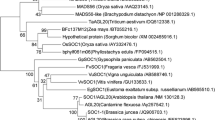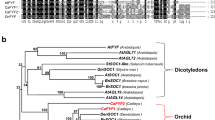Abstract
MADS-box genes are involved in floral organ development. Here we report that an AGL6(Agamous-like 6)-like MADS-box gene, HoAGL6, was isolated from Hyacinthus orientalis L. Expression pattern analysis demonstrated that HoAGL6 transcript was detected in inflorescence buds, tepals, carpels and ovules, but not in stamina, leaves or scales. Transgenic Arabidopsis plants ectopically expressing HoAGL6 exhibited novel phenotypes of significantly reduced plant size, extremely early flowering, and losing inflorescence indeterminacy. In addition, wide homeotic conversion of sepals, petals, and leaves into carpel-like or ovary structures, and disappearance or number reduction of stamens in 35S::HoAGL6 Arabidopsis plants were also observed. RT-PCR analysis indicated that the expressions of flowering time gene SOC1 and flower meristem identity gene LFY were significantly up-regulated in 35S::HoAGL6 transgenic Arabidopsis plants, and the expression levels of floral organ identity genes AG and SEP1 in leaves were also elevated. These results indicated that HoAGL6 was involved in the regulation of flower transition and flower organ formation.
Similar content being viewed by others
References
Kater M M, Dreni L, Colombo L. Functional conservation of MADS-box factors controlling floral organ identity in rice and Arabidopsis. J Exp Bot, 2006, 57(13): 3433–3444
Purugganan M D, Rounsley S D, Schmidt R J, et al. Molecular evolution of flower development: Diversification of the plant MADS-box regulatory gene family. Genetics, 1995, 140: 345–356
Coen E S, Meyerowitz E M. The war of the whorls: Genetic interaction controlling flower development. Nature, 1991, 353: 31–37
Theissen G, Saedler H. Floral quartets. Nature, 2001, 409: 469–471
Theissen G, Becker A, Di Rosa, et al. A short history of MADS-box genes in plants. Plant Mol Biol, 2000, 42: 115–149
Pinyopich A, Ditta G S, Baumann E, et al. Unraveling the redundant roles of MADS-box genes during carpel and fruit development. Nature, 2003, 424: 85–88
Angenent G C, Franken J, Busscher M, et al. A novel class of MADS-box genes is involved in ovule development in petunia. Plant Cell, 1995, 7: 1569–1582
Favaro R, Pinyopich A, Battaglia R, et al. MADS-box protein complexes control carpel and ovule development in Arabidopsis. Plant Cell, 2003, 15: 2603–2611
Pelaz S, Ditta G S, Baumann E, et al. B and C floral organ identity functions require SEPALLATA MADS-box genes. Nature, 2000, 405: 200–203
Pelaz S, Tapia-Lopez R, Alvarez-Buylla E R, et al. Conversion of leaves into petals in Arabidopsis. Curr Biol, 2001, 11: 182–184
Honma T, Goto K. Complexes of MADS-box proteins are sufficient to convert leaves into floral organs. Nature, 2001, 409: 525–529
Theissen G. Development of floral organ identity: Stories from the MADS house. Curr Opin Biol, 2001, 4: 75–85
Drews G N, Bowman J L, Meyerowitz E M. Negative regulation of the Arabidopsis homeotic gene AGAMOUS by the APETALA2 product. Cell, 1991, 65: 991–1002
Mandel M A, Gustafson-Brown C, Savidge B, et al. Molecular characterization of the Arabidopsis floral homeotic gene APETALA1. Nature, 1992, 360: 273–277
Jofuku K D, den Boer B G W, van Montagu M, et al. Control of Arabidopsis flower and seed development by the homeotic gene APETALA2. Plant Cell, 1994, 6: 1211–1225
Colombo L, Franken J, Koetje E, et al. The petunia MADS box gene FBP11 determines ovule identity. Plant Cell, 1995, 7: 1859–1868
Krizek B A, Meyerowitz E M. The Arabidopsis homeotic genes APETALA3 and PISTILLATA are sufficient to provide the B class organ identity function. Development, 1996, 122: 11–22
Parenicová L, de Folter S, Kieffer M, et al. Molecular and phylogenetic analyses of the complete MADS-box transcription factor family in Arabidopsis: New openings to the MADS world. Plant Cell, 2003, 15: 1538–1551
de Folter S, Immink R G H, Kieffer M, et al. Comprehensive interaction map of the Arabidopsis MADS box transcription factors. Plant Cell, 2005, 17: 1424–1433
Alvarez-Buylla E R, Pelaz S, Liljegren S J, et al. An ancestral MADS-box gene duplication occurred before the divergence of plants and animals. Proc Natl Acad Sci USA, 2000, 97: 5328–5333
Gregis V, Sessa A, Colombo L, et al. AGL24, SHORT VEGETATIVE PHASE, and APETALA1 redundantly control AGAMOUS during early stages of flower development in Arabidopsis. Plant Cell, 2006, 18: 1373–1382
Michaels S D, Amasino R M. FLOWERING LOCUS C encodes a novel MADS domain protein that acts as a repressor of flowering. Plant Cell, 1999, 11: 949–956
Sheldon C C, Rouse D T, Finnegan E J, et al. The molecular basis of vernalization: The central role of FLOWERING LOCUS C (FLC). Proc Natl Acad Sci USA, 2000, 97: 3753–3758
Onouchi H, Igeño M I, Périlleux C, et al. Mutagenesis of plants overexpressing CONSTANS demonstrates novel interactions among Arabidopsis flowering-time genes. Plant Cell, 2000, 12: 885–900
Ferrario S, Immink R G, Shchennikova A, et al. The MADS box gene FBP2 is required for SEPALLATA function in petunia. Plant Cell, 2003, 15: 914–925
Bowman J L, Alvarez J, Weigel D, et al. Control of flower development in Arabidopsis thaliana by APETALA1 and interacting genes. Development, 1993, 119: 721–743.
Liljegren S J, Gustafson-Brown C, Pinyopich A, et al. Interactions among APETALA1, LEAFY, and TERMINAL FLOWER1 specify meristem fate. Plant Cell, 1999, 11: 1007–1018
Ma H, Yanofsky M F, Meyerowitz E M. AGL1–AGL6, an Arabidopsis gene family with similarity to floral homeotic and transcription factor genes. Genes Dev, 1991, 5: 484–495
Mouradov A, Glassick T V, Hamdorf B A, et al. Family of MADS-box genes expressed early in male and female reproductive structure of monterey pine. Plant Physiol, 1998, 117: 55–61
Shindo S, Ito M, Ueda K, et al. Characterization of MADS genes in the gymnosperm Gnetum parvifolium and its implication on the evolution of reproductive organs in seed plants. Evol Dev, 1999, 1: 180–190
Tsuchimoto S, Mayama T, van der Krol A, et al. The whorl-specific action of a petunia class B floral homeotic gene. Genes to Cells, 2000, 5(2): 89–99
Boss P K, Sensi E, Hua C, et al. Cloning and characterization of grapevine (Vitis vinifera L.). MADS-box genes expressed during inflorescence and berry development. Plant Sci, 2002, 162(6): 887–895
Mena M, Mandel M A, Lerner D R, et al. A characterization of the MADS-box gene family in maize. Plant J, 1995, 8: 845–854
Zhao T, Ni Z, Dai Y, et al. Characterization and expression of 42 MADS-box genes in wheat (Triticum aestivum L.). Mol Genet Genomics, 2006, 276(4): 334–350
Yao J L, Dong Y H, Kvarnheden A, et al. Seven MADS-box genes in apple are expressed in different parts of the fruit. J Am Soc Hortic Sci, 1999, 124: 8–13
Petersen K, Didion T, Andersen C H, et al. MADS-box genes from perennial ryegrass differentially expressed during transition from vegetative to reproductive growth. J Plant Physiol, 2004, 161(4): 439–447
Becker A, Saedler H, Theissen G. Distinct MADS-box gene expression patterns in the reproductive cones of the gymnosperm Gnetum gnemon. Dev Genes Evol, 2003, 213(11): 567–572
Hsu H-F, Huang C-H, Chou L-T, et al. Ectopic expression of an orchid (Oncidium Gower Ramsey) AGL6-like gene promotes flowering by activating flowering time genes in Arabidopsis thaliana. Plant and Cell Physiol, 2003, 44: 783–794
Moon Y-H, Kang H-G, Jung J-Y, et al. Determination of the motif responsible for interaction between the rice APETALA1/AGAMOUS-LIKE9 family proteins using a yeast two-hybrid system. Plant Physiol, 1999, 120: 1193–1204
Bechtold N, Ellis J, Pelletier G. In planta Agrobacterium mediated gene transfer by infiltration of adult Arabidopsis thaliana plants. C R Acad Sci, 1993, 316: 1194–1199
Mizukami Y, Ma H. Ectopic expression of the floral homeotic gene AGAMOUS in transgenic Arabidopsis plants alters floral organ identity. Cell, 1992, 71: 119–131
Mizukami Y, Ma H. Determination of Arabidopsis floral meristem identity by AGAMOUS. Plant Cell, 1997, 9: 393–408
Carlsbecker A, Tandre K, Johanson U, et al. The MADS-box gene DAL1 is a potential mediator of the juvenile-to-adult transition in Norway spruce (Picea abies). Plant J, 2004, 40(4): 546–557
Preston J C, Kellogg E A. Reconstructing the evolutionary history of paralogous APETALA1/FRUITFULL-like genes in grasses (Poaceae). Genetics, 2006, 174(1): 421–437.
Kyozuka J, Kobayashi T, Morita M, et al. Spatially and temporally regulated expression of rice MADS box genes with similarity to Arabidopsis class A, B and C genes. Plant Cell Physiol, 2000, 41: 710–718
Kater M M, Dreni L, Colombo L. Functional conservation of MADS-box factors controlling floral organ identity in rice and Arabidopsis. J Exp Bot, 2006, 57(13): 3433–3444
Rounsley S D, Ditta G S, Yanofsky M F. Diverse roles for MADS box genes in Arabidopsis development. Plant Cell, 1995, 7(8): 1259–1269
Tandre K, Svenson M, Svensson M E, et al. Conservation of gene structure and activity in the regulation of reproductive organ development of conifers and angiosperms. Plant J, 1998, 15: 615–623
Lee H, Suh S S, Park E, et al. The AGAMOUS-LIKE 20 MADS domain protein integrates floral inductive pathways in Arabidopsis. Genes Dev, 2000, 14: 2366–2376
Nilsson O, Lee I, Blázquez M A, et al. Flowering time genes modulate the response to LEAFY activity. Genetics, 1998, 150: 403–410
Wigge P A, Kim M C, Jaeger K E, et al. Integration of spatial and temporal information during floral induction in Arabidopsis. Science, 2005, 309: 1056–1059
Parcy F, Nilsson O, Busch M A, et al. A genetic framework for floral patterning. Nature, 1998, 395: 561–566
Ruiz-Garcia L, Madueno F, Wilkinson M, et al. Different roles of flowering-time genes in the activation of floral initiation genes in Arabidopsis, Plant Cell, 1997, 9: 1921–1934
Wagner D, Sablowski R W, Meyerowitz E M. Transcriptional activation of APETALA1 by LEAFY. Science, 1999, 285: 582–584
Lamb R S, Hill T A, Tan Q-K, et al. Regulation of APETALA3 floral homeotic gene expression by meristem identity genes. Development, 2002, 129(9): 2079–2086
Hsu H-F, Yang C-H. An orchid (Oncidium Gower Ramsey) AP3-like MADS gene regulates floral formation and initiation. Plant Cell Physiol, 2002, 43: 1198–1209
Hartmann U, Hohmann S, Nettesheim K, et al. Molecular cloning of SVP: A negative regulator of the floral transition in Arabidopsis. Plant J, 2000, 21: 351–360
Gregis V, Sessa A, Colombo L, et al. AGL24, SHORT VEGETATIVE PHASE, and APETALA1 redundantly control AGAMOUS during early stages of flower development in Arabidopsis. Plant Cell, 2006, 18: 1373–1382
Sridhar V V, Surendrarao A, Liu Z. APETALA1 and SEPALLATA3 interact with SEUSS to mediate transcription repression during flower development. Development, 2006, 133(16): 3159–3166
Ferrario S, Busscher J, Franken J, et al. Ectopic expression of the petunia MADS box gene UNSHAVEN accelerates flowering and confers leaf-like characteristics to floral organs in a dominant-negative manner. Plant Cell, 2004, 16: 1490–1505
Trevaskis B, Tadege M, Hemming M N, et al. Short Vegetative Phase-like MADS-Box genes inhibit floral meristem identity in barley. Plant Physiol, 2006, 143: 225–235
Kim S-Y, Yun P-Y, Fukuda T, et al. Expression of a DEFICIENS-like gene correlates with the differentiation between sepal and petal in the orchid, Habenaria radiata (Orchidaceae). Plant Sci, 2007, 172: 319–326
Battaglia R, Brambilla V, Colombo L, et al. Functional analysis of MADS-box genes controlling ovule development in Arabidopsis using the ethanol-inducible alc gene-expression system. Mechan Dev, 2006, 123: 267–276
Author information
Authors and Affiliations
Corresponding author
Rights and permissions
About this article
Cite this article
Fan, J., Li, W., Dong, X. et al. Ectopic expression of a hyacinth AGL6 homolog caused earlier flowering and homeotic conversion in Arabidopsis . SCI CHINA SER C 50, 676–689 (2007). https://doi.org/10.1007/s11427-007-0083-4
Received:
Accepted:
Issue Date:
DOI: https://doi.org/10.1007/s11427-007-0083-4




